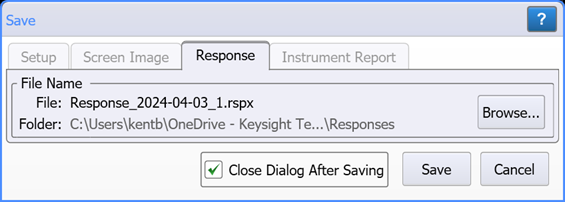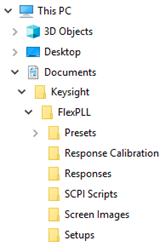Save Response
Use the Save dialog's Response tab to save the Response to a Response file (*.rspx). You can load a Response file into Response Memory for viewing offline.
Response files include calibration data, so there is no need to save a corresponding calibration file.

A Response file includes the following information:
- JTF Source's Jitter settings
- JTF Receiver's Clock Recovery settings
- JTF data
- Calibration data
To save a Response file

- Click Browse to change a target file name and folder that is different from the default.
- Click Save to save the file.
The default user data folder for saving Response files is \Responses.
File Names
After a default setup, the file name assigned to a setup file takes the form Response_2017-04-08_1.rspx. An incremented number "_1" is automatically appended after the date field. With each subsequent file save, this number is incremented. Appending an auto-generated number helps to prevent the accidental writing over of an existing file. Each setup file uses approximately 4 KB of disk space.
If you click Browse, you can replace this automatically generated name with any name that you like. For example, my_file.rspx. In this case, the first file saved will be my_file.rspx. If you have cleared Close Dialog After Saving, the next file will have the characters "_1" appended as in my_file_1.rspx. This number automatically increments on each subsequent save. If you select Close Dialog After Saving, the default file name reverts back to the form Response_<date><autonumber> as described at the beginning of this section.
If you enter a file name that has an arbitrary number appended, for example this_file_57.rspx, FlexPLL will detect this and save the subsequent file as this_file_58.rspx.